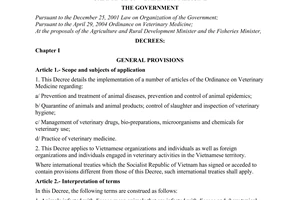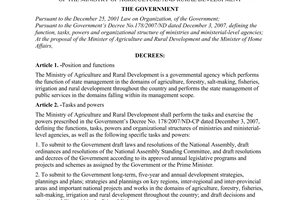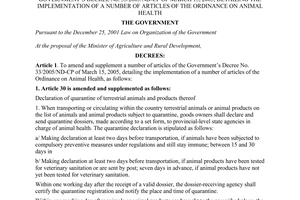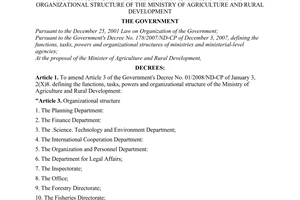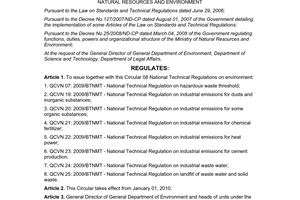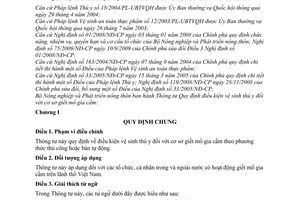Nội dung toàn văn Circular No. 61/2010/TT-BNNPTNT on veterinary hygiene conditions for poultry
|
THE
MINISTRY OF AGRICULTURE AND RURAL DEVELOPMENT |
SOCIALIST
REPUBLIC OF VIET NAM |
|
Hanoi, October 25, 2010 |
CIRCULAR
ON VETERINARY HYGIENE CONDITIONS FOR POULTRY SLAUGHTERHOUSES
Pursuant to Animal Health
Ordinance No. 18/ 2004/PL-UBTVQH which was passed by the National Assembly
Standing Committee on April 29, 2004;
Pursuant to Food Hygiene and Safety Ordinance No. 12/2003/PL-UBTVQH which was
passed by the National Assembly Standing Committee on July 26, 2003;
Pursuant to the Government's Decree No. 01/ 2008/ND-CP of January 3, 2008,
defining the functions, tasks, powers and organizational structure of the
Ministry of Agriculture and Rural Development; and the Government's Decree No.
75/2009/ND-CP of September 10, 2009, amending Article 3 of the Government's
Decree No. 01/2008/ND-CP;
Pursuant to the Government's Decree No. 163/2004/ND-CP of September 7,2004,
detailing a number of articles of the Food Hygiene and Safety Ordinance;
Pursuant to the Government's Decree No. 33/ 2005/ND-CP of March 15, 2005,
detailing a number of articles of the Animal Health Ordinance; and the
Government's Decree No. 119/2008/ND-CP of November 28, 2008, amending and
supplementing a number of articles of the Government's Decree No. 33/2005/
ND-CP;
The Ministry of Agriculture and Rural Development promulgates the circular on
veterinary hygiene conditions for poultry slaughterhouses:
Chapter I
GENERAL PROVISIONS
Article 1. Scope of regulation
This Circular provides veterinary hygiene conditions for slaughterhouses killing poultry by the manual or semi-automatic method.
Article 2. Subjects of application
This Circular applies to domestic and overseas organizations and individuals engaged in poultry slaughter in Vietnam.
Article 3. Interpretation of terms
In this Circular, the terms below are construed as follows:
1. Equipment includes tools and machines used to slaughter, contain, cut and debone, and transport poultry and meat.
2. Cleaning means taking mechanical measures to remove inorganic and organic substances on equipment, tools, safety devices and workshops of slaughterhouses.
3. Sanitization means using physical and chemical agents to exterminate contaminating microorganisms on objects to be sanitized for food safety assurance.
4. Hygiene means conditions for workers, equipment, tools and workshops of slaughterhouses to ensure production in an appropriate environment and products' satisfaction of criteria of safety for users.
5. Production area includes the area for keeping poultry before slaughter and the slaughter area.
6. Slaughter area is the place for stunning, cutting the jugular veins and collecting blood, scalding, defeathering, eviscerating, cleaning edible viscera, washing carcasses for the last time, chilling, checking carcasses and sticking and affixing slaughter control stamps and marks
7. Clean area is the place for final washing, chilling, final inspection of carcasses, cutting and deboning and packing.
8. Unclean area is the place for keeping poultry before slaughter, stunning, cutting the jugular veins and collecting blood, scalding, defeathering and eviscerating poultry and cleaning edible viscera and collecting byproducts.
Chapter II
VETERINARY HYGIENE CONDITIONS
Article 4. Requirements on physical facilities
1. Location:
a/ To conform with local planning and to be licensed by competent agencies.
b/ To be separated from residential areas and far away from animal breeding farms and polluting sources (dumping grounds, plants emitting dust and toxic chemicals, national highways, etc).
c/ To be in areas with stable supply of electricity and water.
d/ To be convenient in transport and far away from rivers and streams used as daily-life water sources.
2. Design and arrangement:
a/ To have surrounding fences or be separated from surrounding areas.
b/ To have separate routes for transporting live poultry and meat, ensuring that vehicles carrying live poultry do not pass the clean area.
c/To have sterilization pits or equipment for sanitizing vehicles and people entering the slaughter area.
d/ To have appropriate solid and liquid waste treatment systems.
f/ To be arranged in two separate areas: the administrative area and the production area.
g/To have a working office for animal health workers in the production area.
Article 5. Requirements on areas for receiving and keeping poultry before slaughter
1. The area for receiving poultry has equipment to enable safe unloading of poultry.
2. The area for keeping poultry before slaughter is suitable to the slaughtering scale and characteristics of each type of poultry:
a/ To have roof to protect poultry from rain and sunshine, to be airy.
b/ To be floored with materials which are solid, non-slippery, easily drained and sanitized and sloped toward wastewater drains.
3. To have a passage for animal health workers to examine poultry before slaughter.
4. To have a water supply system to sanitize vehicles carrying poultry and the poultry keeping area.
Article 6. Requirements on the slaughter area
1. To be designed to enable one-direction slaughter process from unclean to clean areas. The unclean area is separated from the clean area, between them are sanitization pits or troughs.
2. The roof or ceiling is tight, leakless and made of durable and waterproof materials which are easily cleaned and sanitized.
3. Walls inside the slaughter area are made of solid, durable, heatproof, smooth, damp- and mold-proof materials which are easily cleaned and sanitized. The foot of the wall and corner between the floor and pillar are built round or sloping.
4. To have sufficient hand-wash sinks for workers, sinks for washing and sanitizing slaughtering tools and safety devices in places which are conveniently located for cleaning and sanitization.
5. Floor of the slaughter area:
a/ To be made of durable, waterproof and non-slippery materials which are easily cleaned and sanitized.
b/ To be sloped toward the waste collection system to, ensure proper drainage without stagnant water on the floor.
6. For hanging slaughter, the height from the floor to the ceiling must guarantee food safety for meat. The hanging slaughter line is at least 1m below the ceiling.
For manual slaughter, there are tables or platforms for evisceration. Such table or platform is at least 0.9 m high and made of materials which are durable, waterproof and easily cleaned and sanitized.
7. To have a good steam absorption system.
8. The place for cleaning and inspecting carcasses must:
a/ Be airy and hygienic with nets to keep out insects and harmful animals.
b/ Have containers to keep carcasses with feather, alien articles or abrasion or unqualified carcasses to be handled.
c/ To have tables or place for carcass inspection at the end of the hanging slaughter line.
d/ For manual slaughter, to have tables or platforms for loading carcasses for veterinary control.
9. Requirements on chilling and cold preservation of poultry meat at slaughterhouses (if any):
a/ For fresh meat, after cooling, to pack and preserve at a temperature of 0-5°C.
b/ For frozen meat, after cooling, to freeze at a temperature of between -40°C and -50°C, to preserve at a temperature of between -18°C and -20°C.
Article 7. Requirements on wastewater drainage and waste treatment systems
1. Wastewater drainage system:
a/ To have a wastewater drainage system in the areas for loading and unloading, keeping and slaughtering poultry.
b/ To have covered wastewater drains of proper size, which can carry away all waste discharged from the process of slaughter and cleaning of workshops and vehicles transporting poultry.
c/ To have a water drainage system which allows water flow from clean to unclean areas without stagnant water on the floor.
d/ To have wastewater from workers' toilets directly discharged into the outside common wastewater system, which is separate from the wastewater drainage system for the slaughter area.
e/ To have garbage nets and fat and viscera-separating tanks before discharge of wastewater into the wastewater treatment system.
f/ Treated wastewater reaches regulation QCVN 24:2009/BTNMT for the following norms: BOD, COD. Coliforms, pH, NH3, H2 S, TN, TP and TSS specified in Appendix 3 to this Circular (not printed herein).
2. Treatment of solid waste, by-products and unsafe products
a/ To have a place for handling dead poultry and inedible viscera, ensuring no contamination of edible products.
b/ If unable to handle them, to sign a contract with a licensed waste treatment institution.
c/ To have covered containers of waste materials and by-products labeled by their use. To frequently collect waste materials and byproducts at the end of each working shift.
d/ To treat manure and organic waste to mitigate environmental pollution.
e/ To frequently clean up all waste at the end of each slaughtering shift.
Article 8. Requirements on lighting and ventilation
1. Requirements on lighting and illumination power
a/ White illumination power at least reaches 300 Lux in the slaughter and cutting and deboning areas; 500 Lux in the areas of evisceration and veterinary inspection; and 200 Lux in the packing and chilling areas.
b/ All light bulbs have protective nets or shades.
2. Ventilation
a/ The ventilation system is designed to enable air to flow from clean to unclean areas.
b/ Ventilation doors in clean and cutting and deboning areas have nets to keep out insects and harmful animals.
Article 9. Requirements on water and ice
1. Water and hot water:
a/ To have sufficient water and hot water for slaughter and cleaning activities.
b/ To have rules on water quality control and maintenance of the water supply system. To keep dossiers at the facility.
c/ Water used in the slaughterhouse to reach regulation QCVN 01: 2009/BYT.
2. Ice and ice preservation:
a/ To only use ice of clear origin, to have an ice supply contract between the slaughterhouse and ice maker.
b/ Water used for making ice for slaughterhouses to reach regulation QCVN 0L2009/BYT.
c/ To have water and ice analyzed biannually for microorganic, physical and chemical indicators.
d/ To prevent contamination for ice in its transportation and preservation.
Article 10. Requirements on personal hygiene facilities for workers
1. To have sufficient toilets and change rooms for workers.
2. To furnish toilets with sufficient personal hygiene equipment. Toilets to be in proper conditions, airy, clean and completely separate from the slaughter area without doors directly leading to the slaughter area.
3. To have a place for keeping clothes and personal articles of workers, which is separate from the slaughter area.
Article 11. Requirements on equipment and maintenance
1. Equipment:
a/ To have slaughtering equipment made of durable, stainless, non-corroded, non-toxic and waterproof materials.
b/ To use separate tools and utensils for each area.
c/ To keep knives and slaughtering tools hygienic at the slaughterhouse. To have sufficient knife-holding shelves at the slaughterhouse.
d/ To have sufficient sinks with running water and soap for workers to wash hands and tools in different working areas.
2. Maintenance:
a/ To have programs on routine maintenance of equipment to prevent cross contamination of meat. To fully keep maintenance records.
b/ To only maintain and repair equipment and machines at the end of a slaughtering shift after meat is all carried away.
Article 12. Requirements on the warehouse system
1. Warehouses:
a/ To have places for storing and reserving slaughtering equipment separate from places for keeping chemicals. To prevent mold, rain and harmful animals in warehouses.
b/ To preserve packaging and packaging materials in a separate area.
2. Cold stores and containers (if any)
To have thermometers and built-in or remote temperature controllers for each refrigerating equipment.
Article 13. Requirements on cleaning and sanitization
1. To have a cleaning and sanitization process, covering a list of equipment and machines, cleaning and sanitization steps and frequency; chemicals and chemical contents to be used.
2. To regularly maintain the process to clean and sanitize workshops, equipment and tools.
3. To examine sanitary conditions of workshops, equipment and tools before each slaughtering shift. To conduct slaughtering only after workshops, equipment and tools meet sanitary requirements. Hygiene criteria for tools are specified in Appendix 2 to this Circular (not printed herein).
4. To regularly take samples for hygiene examination of slaughtering tools and workshops. To record examination results and cleaning measures in dossiers of the slaughterhouse.
Article 14. Requirements on control of insects and harmful animals
1. To have effective appropriate processes and measures to control insects and harmful animals in the slaughterhouse.
2. To only use permissible traps or chemicals to kill insects and harmful animals in the slaughterhouse.
3. Not to keep birds, dogs, cats and any other animals in the slaughter area.
Article 15. Hygiene requirements for workers
1. Health requirements
a/ Slaughterers receive health checks before recruitment and biannually under the Ministry of Health's regulations.
b/ Sufferers of infectious and dermatological diseases on the list of the Ministry of Health may not directly participate in the slaughter process.
2. Personal hygiene in the slaughterhouse
a/ Slaughterers must wear safety devices which must be cleaned before and after each slaughtering shift.
b/ Those with an open wound must have such wound dressed with unabsorbent materials.
c/ To maintain rules on personal hygiene: to properly use safety devices, not to wear jewelry while working.
d/ Not to eat. drink, smoke and spit in the slaughter area.
e/ Not to bring food into the slaughter area.
g/ To wash hands with soap before slaughter and after touching products, using the toilet or touching contaminated materials.
Article 16. Requirements for visitors
All visitors must fully wear safety devices and observe cleaning and sanitization requirements of the slaughterhouse.
Article 17. Requirements on transportation
1. Transportation of poultry to slaughterhouses:
a/ Poultry transported to a slaughterhouse has a certificate of transportation quarantine issued by a competent animal health agency, or vaccination certificate or certificate of poultry origin issued by a grassroots animal health office.
b/ Vehicles carrying poultry are made of durable materials which arc easily cleaned and sanitized.
c/ Vehicles' floor is tight to prevent manure and waste from dropping on the way.
d/ Vehicles are cleaned after transportation.
2. Transportation of meat and viscera to places of consumption:
a/ Before being brought out of a slaughterhouse, meat bears a slaughter control mark or veterinary hygiene stamp.
b/ Vehicles transporting meat have tightly closed doors and are made of durable and waterproof materials which are easily cleaned and sanitized,
c/ Vehicles carrying live animals, manure, chemicals or waste may not be used to transport meat.
d/ Vehicles' meat containers are cleaned and sanitized before loading meat.
f/ Vehicles" meat containers have doors tightly closed during transportation.
g/ Meat unloading measures minimize contamination,
Article 18. Requirements on slaughter
1. Slaughter process:
a/ To have a poultry slaughter process, covering the order and operations from stunning, collecting blood, scalding, defeathering, washing and evisceration, cleaning, chilling, cutting and deboning, packing and disposing of by-products.
b/ The slaughter process is suitable to the slaughtering scale and techniques to assure food safety.
c/ To control evisceration to minimize carcass contamination.
d/ The slaughterhouse provides regular training in the slaughter process and food safety assurance measures for each group of workers.
2. Slaughter control:
a/ To have animal health workers to control slaughter under Decision No. 87/2005/QD-BNN.
b/ Hygienic carcasses and edible viscera bear a laughter control mark or veterinary hygiene stamp and obtain a certificate of animal product transportation quarantine under regulations.
c/ Animal health workers guide the disposal of dead poultry, viscera and by-products under regulations.
Article 19. Requirements on technical management of slaughter
1. The slaughterhouse must assign a person responsible for veterinary hygiene to assure food safety in slaughter.
2. Technicians shall control the observance of the slaughter process and veterinary hygiene conditions in the slaughterhouse.
Chapter III
PROVISIONS ON MANAGEMENT
Article 20. Certification of veterinary hygiene conditions to assure food safety
1. Slaughterhouses shall be biennially examined and granted certificates of satisfaction of veterinary hygiene conditions by animal health agencies.
2. The examination order and process comply with the Ministry of Agriculture and Rural Development's regulations.
Article 21. Inspection and examination
1. Slaughterhouses shall conduct self-examination and be inspected and examined regularly or extraordinarily by competent state management agencies. Examination contents are specified in Appendix 1 to this Circular (not printed herein).
2. Inspection, examination, and handling of violations comply with current law.
Chapter IV
ORGANIZATION OF IMPLEMENTATION
Article 22. Responsibilities of the Animal Health Department
1. To guide owners of slaughterhouses, slaughterers and animal health workers in provinces and cities in implementing this Circular.
2. To train in inspection and evaluation methods for inspection and examination officers.
3. To inspect and evaluate slaughterhouses in taking measures to improve veterinary hygiene conditions for food safety assurance.
Article 23. Responsibilities of Animal Health Sub-Departments
1. To train and direct local slaughterhouses in the implementation of this Circular.
2. To examine and grant certificates of veterinary hygiene to eligible slaughterhouses under this Circular.
3. To regularly and irregularly inspect and examine slaughterhouses under their management.
Article 24. Responsibilities of slaughterhouses
1. To be managed and supervised by competent state management agencies.
2. To provide documents and information related to, and create conditions for sampling for, examination and supervision when so requested.
3. To fulfill obligations prescribed by law.
Chapter V
IMPLEMENTATION PROVISIONS
Article 25. Effect
This Circular takes effect 45 days from the date of its signing. All regulations which are contrary to this Circular are annulled.
Article 26. Amendment and supplementation
Any problems arising in the course of implementation should be reported to the Ministry of Agriculture and Rural Development for consideration, amendment and supplementation.-
|
|
FOR
THE MINISTER OF AGRICULTURE AND RURAL DEVELOPMENT |



